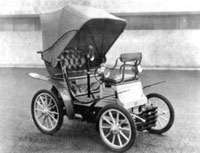
Fiat began on 11th July 1899 when the Societa aninima Fabbrica Italiana di Automobili
- Torino was formed. The first car was the 3½HP (or 4HP) with a
679cc engine and capable of 35km/h. Around 25 were produced. This was produced
in the factory on Corso Dante where 150 workers were employed. Other models
followed soon, the 8, then 10, then 12HP. The 8HP was the first front engined
Fiat, with a two cylinder 1082cc engine producing 10hp, built at a rate
of one per week. The 12HP, with a 3768cc engine was the first Fiat to be
widely exported, around Europe and to the US. A total of 134 were built.
During these first ten years, Fiat also
diversified into the production of trucks, buses, trams and marine and
aero engines and became involved in motorsport.
Six new models were introduced in 1910, the 12-15HP (1847cc, 1000 produced),
the 15-20HP (2612cc), the 20-30HP (3969cc), the 30-45HP (5699cc) and two
50-60HP (9025cc). The first mass produced Fiat, the Zero 12-15HP
was introduced in 1912. This used a 1847cc engine producing 18hp and over
2000 were built up until 1915. 1912 also saw a Fiat, the S76, set the world
land speed record. This monster was powered by a 28355cc four cylinder
engine with three spark plugs per cylinder and 290hp. The war years saw
Fiat producing mainly trucks for military use.
The V12 Superfiat
was introduced in 1921 (6805cc and 90hp), the same year that Polski Fiat
was founded in Poland, whilst in Italy in 1923 the Lingotto factory was
opened. Models in the 1920's included the 519
(1922) with a 4766cc six cylinder engine, the 509
(1925) with a 990cc engine producing 22hp, which won the Montecarlo Rally
in 1928, the 503 (1926) built only for two
years (42,000 cars), the 520 (1927) with
a 2244cc engine and the 514 (replacing the
509 in 1929 after a production run of about 90,000) which used a 1438cc
engine and featured hydraulic suspension. Around 32,000 were bult up to
1932. The 1920's also saw the first use of an aluminium cylinder head in
a production engine, obviously a Fiat, in 1928.
At the Milan Motorshow some three years
later, in 1935, Fiat introduced the 1500. this was the first Fiat production
car to benefit significantly from aerodynamics, it was developed using
a wind tunnel. It had a six cylinder 1493cc engine with 45hp, four speed
transmission and was produced until 1948 (42,500 built). 1919 saw the introduction of several new models. The 501,
with a 23hp 1460cc four cylinder engine, was produced until 1926, by which
time around 45,000 had been built. The 505,
introduced in the same year was a 'bigger brother' of the 501, with a 2296cc
engine. The top of the range was the 510
with a 3446cc six cylinder engine.
1919 saw the introduction of several new models. The 501,
with a 23hp 1460cc four cylinder engine, was produced until 1926, by which
time around 45,000 had been built. The 505,
introduced in the same year was a 'bigger brother' of the 501, with a 2296cc
engine. The top of the range was the 510
with a 3446cc six cylinder engine.
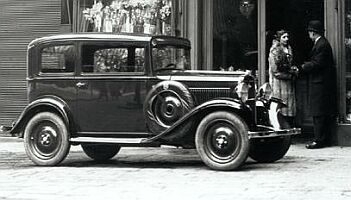 The Milan Motorshow of 1932 saw the introduction of the new 508
Balilla. This had a 995cc four cylinder engine with 20hp and a three
speed gearbox. The first series ran until 1934, by which time 41,395 cars
had been produced. It was facelifted in 1934 and adopted a four speed
gearbox, reulting in the second series, of which 71,700 were built until
1937. 1932 also saw the introduction of the 518
Ardita 1750, later increased to 2000, and the 527 Ardita 2500.
The Milan Motorshow of 1932 saw the introduction of the new 508
Balilla. This had a 995cc four cylinder engine with 20hp and a three
speed gearbox. The first series ran until 1934, by which time 41,395 cars
had been produced. It was facelifted in 1934 and adopted a four speed
gearbox, reulting in the second series, of which 71,700 were built until
1937. 1932 also saw the introduction of the 518
Ardita 1750, later increased to 2000, and the 527 Ardita 2500.
The 508 Balilla was developed into the
New Balilla 1100 or 508C with a new 1084cc engine and styling similar to
the 1500, produced from 1937 to 1939 (about 57,000 cars) and then became
the 1100 and was produced until 1948 (around 74,000 units).
1939 saw the start of the war and thus
the turning of most Fiat capacity to military requirements, it was also
the year in which the Mirafiori factory was opened, employing 22,000 workers.
After the war in 1948 the range was revised,
becoming the 1100B (25,000 built) and 1500D and the 500B (21,000 produced)
which incorporated many changes. In 1949 the 500C
was introduced at the Geneva Motorshow with a completely new bodyshell.
This continued in production until 1955 by which time 376,370 cars had
been produced, bringing total 500 production to around 550,000 cars. 1949
also witnessed the introduction of the 1100E and 1500E, both further developments of the pre-war cars.
The old 1100 soldiered on, and was heavily
revised in 1953 as the 103. This series, which
included an estate (Familiare) continued in production until 1956 when
it was facelifted and became the 103E and was produced for another year.
In 1953 Fiat also launched their first diesel powered car, the 1400 diesel
(although the engine was a 1901cc unit!), of which they produced some 13,500
until 1954. That year saw the introduction of the 1400A and 1900A facelifted
models, revised again in 1958 to become the 1400B and 1900B.
The Geneva Motorshow was again the launch
site for a new model in 1955, this time the 600.
This had a four cylinder 633cc engine mounted at the rear and was built
in large numbers (about 950,000) until 1960. The range included the Multipla
(introduced in 1956), a mini-MPV with three rows of seats, the latter two
folding into the floor. Given a new 767cc engine in 1960 the 600 became
the 600D. Four years later it got front hinged doors and a year after that
was slightly revised. The 600 continued in production until 1969 by which
year a total of 2,695,197 cars had been built.
1957 was also the year when the new 1200
was introduced, developed from the 103. Two years later, in 1959, a new
family of six-cylinder engined cars, the 1800
and 2100 were introduced to replace the 1400/1900.
These were revised in 1961, the 2100 became a 2300
whilst the 1800 became the 1800B. Both mechanical and styling modifications
were made to the range which included a saloon, estate and coupe.
The new 1300/1500
family was introduced in 1961 to replace the 1200, and was the first Fiat
production car to feature disc brakes. It continued in production until
1967 as a saloon, estate and cabriolet. The 600 evolved into the 850
which was released in 1964 and featured a 843cc motor it two states of
tune, with 34 or 37bhp. Coupe, spider and estate versions were built from
1965, and in 1968 a 903cc engine was introduced in the coupe and spider. Production stopped in 1972.
In March 1966, at the Geneva Motorshow,
the Fiat 124 was revealed. This replaced the 1300/1500
family and was awarded car of the Year in the same year. Featuring an 1197cc engine,
the 124 was produced in saloon, estate (Familiare), Spider (designed by
Pininfarina) and Coupe form. The latter two models were introduced in 1966
and 1967 respectively and featured common mechanicals, including a 1438cc dohc engine.
With the help of Ferrari, there appeared
in 1966 a 1987cc V6 engined car, the Dino Spider.
Joined a year later by a Coupe model, a 2418cc engine replaced the 1987cc unit in 1969.
Fiat introduced front-wheel drive in March
1969 in the form of the 128. This used the 1116cc
engine from the 1100 but was otherwise all new and replaced that model.
In that same year Fiat purchased Lancia. In 1971 a coupe version
was shown. That year also saw the introduction of the 127,
and was followed a year later by the 132 to replace
the 125. The 132 was heavily revised and relaunched as the Argenta
in 1981. 1972 saw two further significant model launches, the X1/9
designed by Bertone and the 126 to replace the 500.
Jumping on, 1974 saw the introduction of
the 131 followed in 1978 by the Ritmo,
1980 by the Panda and 1983 by the Uno.
1984 saw Fiat purchase Alfa Romeo.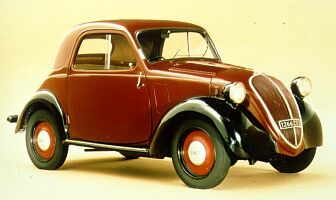 Maybe
the most famous Fiat, the 500 'Topolino', was
first shown in 1936. A small (the smallest mass produced car in the world
at the time), two seater, it was powered by a 569cc four cylinder engine
with just 13bhp. Up to 1948 122,000 were produced.
Maybe
the most famous Fiat, the 500 'Topolino', was
first shown in 1936. A small (the smallest mass produced car in the world
at the time), two seater, it was powered by a 569cc four cylinder engine
with just 13bhp. Up to 1948 122,000 were produced.
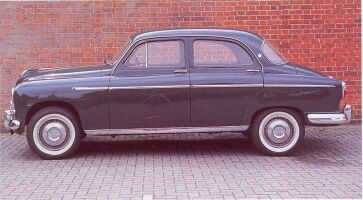 The 1400,
first seen at the Geneva Motorshow in 1950, was the first all new Fiat
after the war. It was also the first Fiat to have a structural body, and
was built until 1954 (77,000 cars). Two years after the launch of the 1400
there appeared a bigger brother, the 1900. In between,
in 1951, Fiat launched the Campagnola, a
four-wheel drive jeep like vehicle, mainly for the military.
The 1400,
first seen at the Geneva Motorshow in 1950, was the first all new Fiat
after the war. It was also the first Fiat to have a structural body, and
was built until 1954 (77,000 cars). Two years after the launch of the 1400
there appeared a bigger brother, the 1900. In between,
in 1951, Fiat launched the Campagnola, a
four-wheel drive jeep like vehicle, mainly for the military.
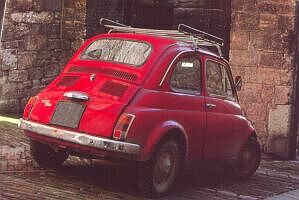 Two years after the 600 came the new 500, also with
a rear mounted engine, this time a two cylinder 479cc unit. 1958 saw the
arrival of the 500 Sport with a larger 499,5cc engine which was introduced
to the rest of the family in 1960 with the arrival of the 500D. That year
also saw the introduction of the Giardinetta, the estate version. These models
continued until 1965 when the 500F arrived with numerous changes to the
engine and body. Production of the 500 finally ceased in 1975.
Two years after the 600 came the new 500, also with
a rear mounted engine, this time a two cylinder 479cc unit. 1958 saw the
arrival of the 500 Sport with a larger 499,5cc engine which was introduced
to the rest of the family in 1960 with the arrival of the 500D. That year
also saw the introduction of the Giardinetta, the estate version. These models
continued until 1965 when the 500F arrived with numerous changes to the
engine and body. Production of the 500 finally ceased in 1975.
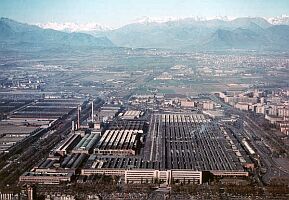 A bigger version of the 124 appeared as the 125 in
1967, designed to replace the 1500. The mechanicals of the 1500 were used,
coupled with the 1608cc dohc engine from the 124. Two years later the 2300
was replaced by the new 130, powered by a 2866c V6 engine.
A bigger version of the 124 appeared as the 125 in
1967, designed to replace the 1500. The mechanicals of the 1500 were used,
coupled with the 1608cc dohc engine from the 124. Two years later the 2300
was replaced by the new 130, powered by a 2866c V6 engine.
 For books on the history of Fiat try
our online bookshop - in Association with Amazon.com & Amazon.co.uk
For books on the history of Fiat try
our online bookshop - in Association with Amazon.com & Amazon.co.uk
Copyright © 2000 to 2008 CarsfromItaly